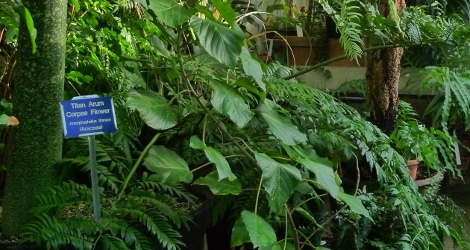Accession Data:
Pittosporum crassifolium Banks & Soland. ex A. Cunn.
- Common Name: Karo
- Family: Pittosporaceae R.Br.
- Country of Origin: North and South Kermedic Islands {New Zealand}
- Habitat: Forest margins and by streams
- Description: Shrub or small tree, to 5m, bark smooth, dark gray; leaves ovate), and broadly tapering to each end; wider than oblanceolate.">obovate or oblanceolate, to 3 inches long, leathery, whitish-tomentose beneath, with about 5 pairs of secondary veins, margins thickened and revolute; flowers dark red to purple, to 1/2 inch long, in 10-flowered terminal clusters; capsules globose to elliptic, usually 3-valved, to 1.5 inches long, gray-tomentose, seeds black.
- Uses: A dark blue dye is obtained from the seeds. The plant is a potential source of saponins. Saponins can be used to as a soap and, because of their bitter taste, they also have potential as a bird deterrent by spraying them over the plants. The bitterness can be easily removed by washing (or by the next rainfall!). Very tolerant of pruning and maritime exposure, this plant can be grown as a protective hedge by the coast in mild maritime areas. Wood - very tough. Used for inlay.
- Culture: Succeeds in any well-drained soil, including dry soils, preferably in a sunny position but also succeeding in light shade. Plants are very resistant to maritime exposure. Very amenable to pruning, plants can be cut right back into old wood if required.
The species in this genus are very likely to hybridize with other members of the genus. When growing a species from seed it is important to ensure that the seed either comes from a known wild source, or from isolated specimens in cultivation.Seed - sow when ripe in the autumn or in February in a warm greenhouse. The seed usually germinates freely. Prick out the seedlings into individual pots when they are large enough to handle, move the plants to a cold frame as soon as they are established and plant out late in the following spring. Cuttings of half-ripe wood, 5 - 7cm with a heel, July/August in a frame. Poor to fair percentage. Basal ripewood cuttings late autumn in a cold frame
- USDA Zone: 8-10
Accession Data:
- Accession # 199300007
- Source: Bonn. Bot. Gar.
- Accession Date: 12-31-1993
- Bench: 2312 - NZ/Australia - Low
- Currently: plants missing
- Qty: 1 confirmed on 12-29-2018
Classification:
- Division: Magnoliophyta
- Class: Magnoliopsida
- SubClass: euasterid II
- Order: Apiales
- SubOrder:
- Family: Pittosporaceae
- SubFamily:
- Tribe:
- SubTribe:
Flowering Data:
This accession has been observed in bloom on:| Year | Jan | Feb | Mar | Apr | May | Jun | Jul | Aug | Sep | Oct | Nov | Dec | ||||||||||||||||||||||||||||||||||||||||
|---|---|---|---|---|---|---|---|---|---|---|---|---|---|---|---|---|---|---|---|---|---|---|---|---|---|---|---|---|---|---|---|---|---|---|---|---|---|---|---|---|---|---|---|---|---|---|---|---|---|---|---|---|
| 2018 | ||||||||||||||||||||||||||||||||||||||||||||||||||||
| 2017 | ||||||||||||||||||||||||||||||||||||||||||||||||||||
| 2016 | ||||||||||||||||||||||||||||||||||||||||||||||||||||
| 2015 | ||||||||||||||||||||||||||||||||||||||||||||||||||||
| 2014 | ||||||||||||||||||||||||||||||||||||||||||||||||||||
| 2013 | ||||||||||||||||||||||||||||||||||||||||||||||||||||
| 2012 | ||||||||||||||||||||||||||||||||||||||||||||||||||||
| 2011 | ||||||||||||||||||||||||||||||||||||||||||||||||||||
| 2010 | ||||||||||||||||||||||||||||||||||||||||||||||||||||
| 2009 | ||||||||||||||||||||||||||||||||||||||||||||||||||||
References (internal):
References (external):
Plants For A Future Website Hortus Third, LH Bailey Hortorium, 1976
data regenerated on Sat, 29 Dec 2018 15:06:01 -0500 [bcm v4.0]
Images:

Additional images for this accession:
Click on thumbnails to enlargeCurrent Accessions in the Pittosporaceae
W/C = Wild Collected = indicates flowering in past 14 days
= indicates flowering in past 14 days
 = images available for this accession
= images available for this accession
 = map available for this accession
= map available for this accession
 = accession added within past 90 days
= accession added within past 90 days
